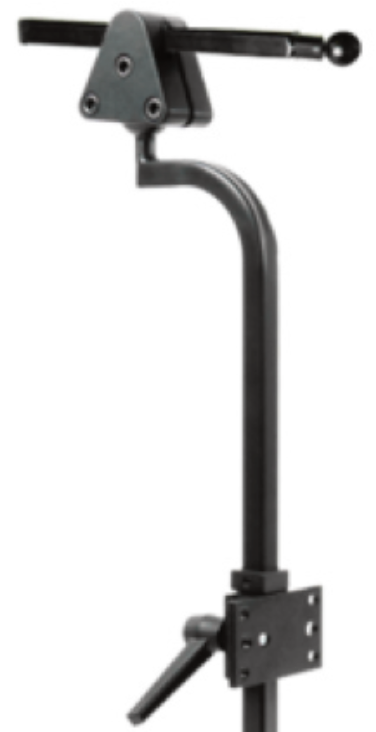Categories
Speciality Areas
What makes a good head support? Part 2: getting the mounting right

The position of our head is critical for many of our day-to-day functions. For many wheelchair users, external assistance is needed to help to move or hold the head in an appropriate position. There’s a wide choice of different styles of head support, as discussed in the previous article in this series, depending on whether restraint and/or rest and/or support is required of the device. In this article we consider aspects around the elements and choices of mounting systems, to position the head support in its optimum position.
An appropriate head position is important for hearing, balance, breathing, eating and swallowing, vision, and most of all social interaction. Where we have limited or loss of muscle control for positioning our head, we rely on a head support on our seating system. To get our head into an optimal position depends on how the whole seating system is set up.
First, we need to have a properly placed pelvic positioning belt to ensure that the pelvis is stabilised without any risk of slipping down in the seat. Next, we need to make sure that the upper body is properly supported. This may need the addition of anterior supports such as a shoulder or chest harness, and also lateral support.
In all cases there will be a posterior support of some type, in the form of a back support. The latter itself might consist of more than one segment (but that is a topic of another article!). It is on the back support that the head support is most likely to be mounted, so it is here that we start with some considerations to be addressed. Is the back support model being used tall enough to mount the head support at the correct height? Has the back support been mounted off-centre to accommodate a degree of hip rotation or spinal scoliosis, but the occupant requires a more central head position. Does the back support have predrilled holes for mounting a head support, and if so are these in a limited number of positions – or does the manufacturer (as with the Varilite Icon back support range) permit holes to be drilled wherever the clinician wishes/needs to do so?
It is also important to ensure that the postural support elements, including the head support, can be maintained (or easily recovered) into the correct position in the chair when a recline function is utilised.
Anatomy of a head support mounting system
There’s a number of components of a mounting system which need to be considered. The first of these is the mounting point of the hardware to the head support. For a simple head support that is just being used as a head restraint or rest, then this may be a fixed point, but for many head supports the mount is on a ball joint, which allows intimate adjustment around the occupant’s head.
The hardware on which the ball is mounted needs to be adjusted in space, usually in the anterior/posterior plane, so that the head support pad is far enough forward, remembering that the back of the head is usually quite some distance forward of the plane of the back support, especially if the occupant has a kyphotic spine. This is achieved by different manufacturers’ different linkage systems (Figure 1).

If the head support has a neck support element, then the attachment for the head support mount needs to have a ‘flip-down’ element (Figure 2), to pull the head support back from around the neck, without catching the ears, when the occupant wishes to leave their seat.

Figure 2. Flip-down mechanism to move the head support away so the occupant can leave their chair
This head support mount will normally then have a vertical element which gives height adjustability, connection to the back support, and as appropriate, the means to offset the head support from the centreline. The latter can be achieved by the design of the vertical element of the support (Figure 3), or by a track mount on the back support (Figure 4).

Figure 3. Head support mounting system where the square tubed angled vertical mount can be rotated 90° to take the head support off centre

Finally, there is the mount to attach the whole assembly to the back support. Currently there is no standardised system for mounting ‘after market’ head supports to the wide range of proprietary wheelchair back supports, and thus you may need a specifically designed interface to attach the mounting system to that manufacturer’s seating system. For example, to mount the Stealth i2i to a broad range of back supports, BES Healthcare offers a range of a dozen different back support interfaces.
Dynamic interfaces
Most head supports are mounted on solid and static hardware. However, the distance between most head supports and the mounting position on the back support means there is quite some leverage along the vertical part of the head support assembly where, for example, an occupant goes into an extensor spasm. There are devices available on the market which are designed to absorb some of these forces.
Some are spring-loaded devices which absorb the forces at the back support mounting position (Figure 5), or just along the plane of the head support mount (Figure 6), whereas others, such as Stealth’s Tone Deflector (Figure 7), make use of an array of shock absorbers that absorb the forces with up to 10° movement horizontally and vertically.

Figure 5. Spring-loaded dynamic system to absorb loads on a head support mounting system

Figure 6. Example of a spring-loaded dynamic head support mounting system

Figure 7. A shock absorber style dynamic head support mounting system
A different twist as a dynamic interface is Symmetric’s Axion Rotary Interface which has the head support mounted on a track that allows the occupant to move their head sideways while still being fully supported by the head support (Figure 8), and thereby reducing shear forces on the back of the head.

Summary
For many wheelchair occupants, their head support is critical to help them get their heads in the right position for normal daily functional activities. Getting, and indeed maintaining, the support in the right position is often critical to achieve this functionality. Using the right hardware in the right configuration can make the difference between success and failure: fortunately, there is a wide choice on the market to achieve most requirements.